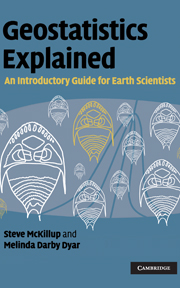Book contents
- Frontmatter
- Contents
- Preface
- 1 Introduction
- 2 “Doing science”: hypotheses, experiments and disproof
- 3 Collecting and displaying data
- 4 Introductory concepts of experimental design
- 5 Doing science responsibly and ethically
- 6 Probability helps you make a decision about your results
- 7 Working from samples: data, populations and statistics
- 8 Normal distributions: tests for comparing the means of one and two samples
- 9 Type 1 and Type 2 error, power and sample size
- 10 Single-factor analysis of variance
- 11 Multiple comparisons after ANOVA
- 12 Two-factor analysis of variance
- 13 Important assumptions of analysis of variance, transformations and a test for equality of variances
- 14 Two-factor analysis of variance without replication, and nested analysis of variance
- 15 Relationships between variables: linear correlation and linear regression
- 16 Linear regression
- 17 Non-parametric statistics
- 18 Non-parametric tests for nominal scale data
- 19 Non-parametric tests for ratio, interval or ordinal scale data
- 20 Introductory concepts of multivariate analysis
- 21 Introductory concepts of sequence analysis
- 22 Introductory concepts of spatial analysis
- 23 Choosing a test
- Appendices
- References
- Index
23 - Choosing a test
Published online by Cambridge University Press: 05 June 2012
- Frontmatter
- Contents
- Preface
- 1 Introduction
- 2 “Doing science”: hypotheses, experiments and disproof
- 3 Collecting and displaying data
- 4 Introductory concepts of experimental design
- 5 Doing science responsibly and ethically
- 6 Probability helps you make a decision about your results
- 7 Working from samples: data, populations and statistics
- 8 Normal distributions: tests for comparing the means of one and two samples
- 9 Type 1 and Type 2 error, power and sample size
- 10 Single-factor analysis of variance
- 11 Multiple comparisons after ANOVA
- 12 Two-factor analysis of variance
- 13 Important assumptions of analysis of variance, transformations and a test for equality of variances
- 14 Two-factor analysis of variance without replication, and nested analysis of variance
- 15 Relationships between variables: linear correlation and linear regression
- 16 Linear regression
- 17 Non-parametric statistics
- 18 Non-parametric tests for nominal scale data
- 19 Non-parametric tests for ratio, interval or ordinal scale data
- 20 Introductory concepts of multivariate analysis
- 21 Introductory concepts of sequence analysis
- 22 Introductory concepts of spatial analysis
- 23 Choosing a test
- Appendices
- References
- Index
Summary
Introduction
Statisticians and earth scientists who teach statistics are often visited in their offices by a researcher or student they may never even have met before, who is clutching a dauntingly thick pile of paper and perhaps a couple of flash drives or CDs with labels like “Experiment 1” or “Trial 2”. The visitor sits down, drops everything heavily on the desk and says, “Here are my results. What stats do I need?”
This is not a good thing to do. First, the person whose advice you are asking may not have the time to work out exactly what you have done, so they may give you bad advice. Second, the answer can be a very nasty surprise like “There are problems with your experimental design.”
The decision about the appropriate statistical analysis needs to be made by considering the hypothesis being tested, the experimental design and the type of data. It can save a lot of time, trouble and disappointment if you think about possible ways of analyzing the data before the sampling is done or the experiment designed, rather than only after the data have been collected.
Tables 23.1–23.12 are a guide to choosing an appropriate analysis from the ones discussed in this book. You need to start at Table 23.1, which initially gives five columns that are mutually exclusive alternatives. Once you have decided among these, work downwards within the column you have chosen.
- Type
- Chapter
- Information
- Geostatistics ExplainedAn Introductory Guide for Earth Scientists, pp. 364 - 373Publisher: Cambridge University PressPrint publication year: 2010

